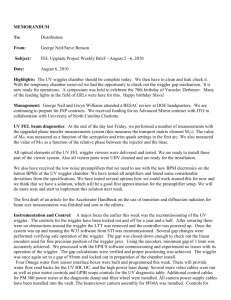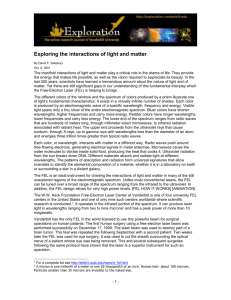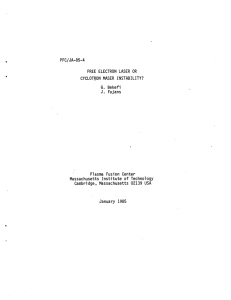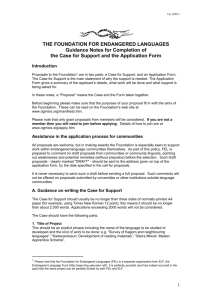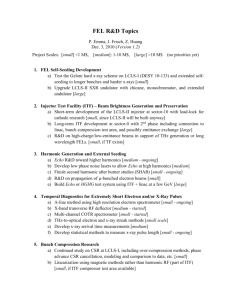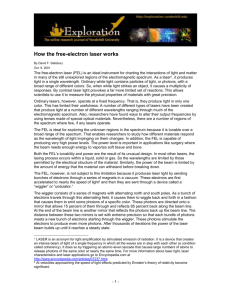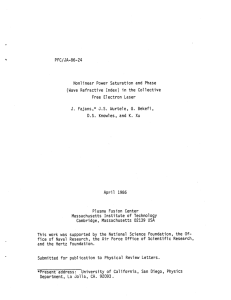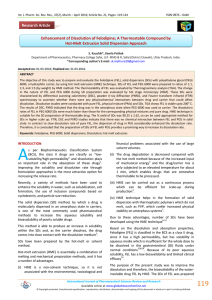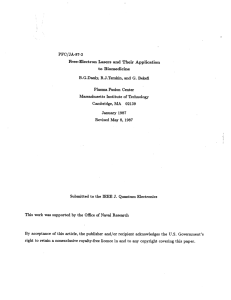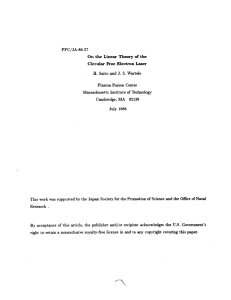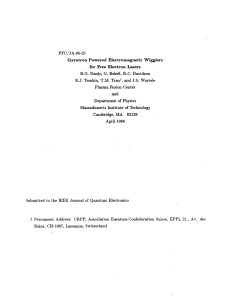August 9-August 13, 2010
advertisement
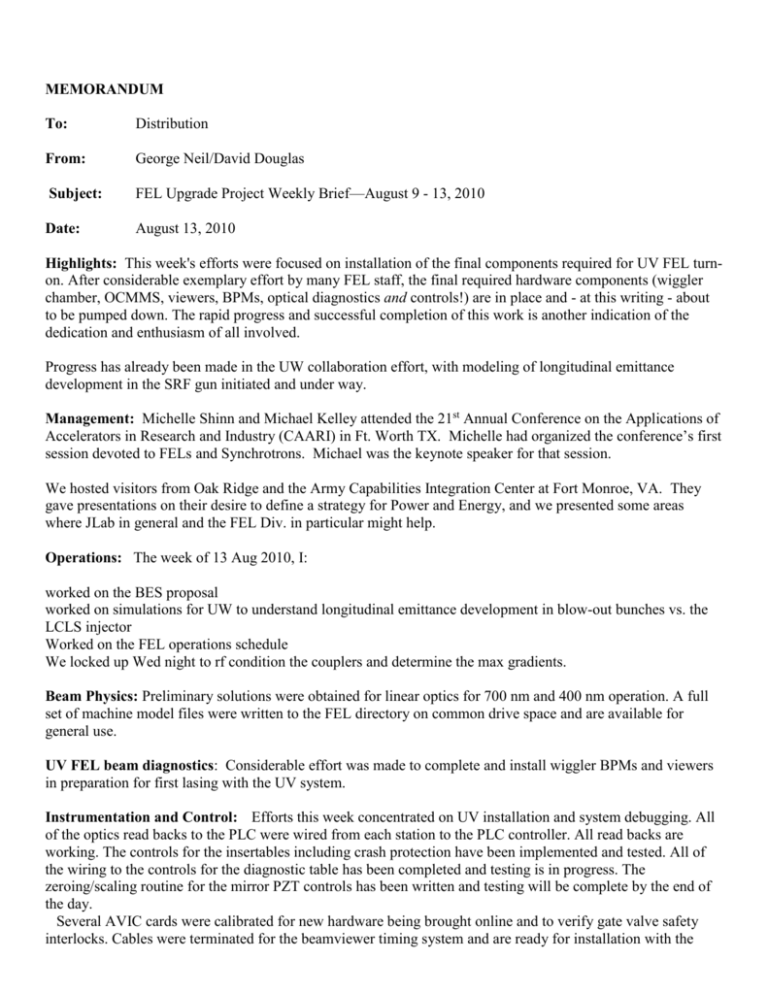
MEMORANDUM To: Distribution From: George Neil/David Douglas Subject: FEL Upgrade Project Weekly Brief—August 9 - 13, 2010 Date: August 13, 2010 Highlights: This week's efforts were focused on installation of the final components required for UV FEL turnon. After considerable exemplary effort by many FEL staff, the final required hardware components (wiggler chamber, OCMMS, viewers, BPMs, optical diagnostics and controls!) are in place and - at this writing - about to be pumped down. The rapid progress and successful completion of this work is another indication of the dedication and enthusiasm of all involved. Progress has already been made in the UW collaboration effort, with modeling of longitudinal emittance development in the SRF gun initiated and under way. Management: Michelle Shinn and Michael Kelley attended the 21st Annual Conference on the Applications of Accelerators in Research and Industry (CAARI) in Ft. Worth TX. Michelle had organized the conference’s first session devoted to FELs and Synchrotrons. Michael was the keynote speaker for that session. We hosted visitors from Oak Ridge and the Army Capabilities Integration Center at Fort Monroe, VA. They gave presentations on their desire to define a strategy for Power and Energy, and we presented some areas where JLab in general and the FEL Div. in particular might help. Operations: The week of 13 Aug 2010, I: worked on the BES proposal worked on simulations for UW to understand longitudinal emittance development in blow-out bunches vs. the LCLS injector Worked on the FEL operations schedule We locked up Wed night to rf condition the couplers and determine the max gradients. Beam Physics: Preliminary solutions were obtained for linear optics for 700 nm and 400 nm operation. A full set of machine model files were written to the FEL directory on common drive space and are available for general use. UV FEL beam diagnostics: Considerable effort was made to complete and install wiggler BPMs and viewers in preparation for first lasing with the UV system. Instrumentation and Control: Efforts this week concentrated on UV installation and system debugging. All of the optics read backs to the PLC were wired from each station to the PLC controller. All read backs are working. The controls for the insertables including crash protection have been implemented and tested. All of the wiring to the controls for the diagnostic table has been completed and testing is in progress. The zeroing/scaling routine for the mirror PZT controls has been written and testing will be complete by the end of the day. Several AVIC cards were calibrated for new hardware being brought online and to verify gate valve safety interlocks. Cables were terminated for the beamviewer timing system and are ready for installation with the viewers. Documentation updates for the vacuum system and timing system are underway in preparation for system handover. Digital and hard copies of everything are being generated and organized, and drawings are being done. After the wiggler chamber installation, we unlocked the wiggler's controller and began checkout. The wiggler jaws were closed down at safe intervals checking clearances between them and the chamber. The chamber was about 0.5mm high and was adjusted before each subsequent move. We were not able to safely make minimum gap due to the chamber walls being slightly rounded out. Once under vacuum the chamber would be straightened out and have the proper clearances. There will only be a 0.5mm gap on each side of the chamber at minimum gap. The optical transport PLC was commissioned with full software checkout. The PLC is correctly reading back and all channels were rung out. The last details for proper scaling of the raw data was determined and saved on the IOC. The screens were finalized for all the RTD, thermocouples, and water flow read backs. The screens for these have been nicely consolidated for easy calibration and alarm set points. The individual heater controls for FL03 were tested live on swing shift this week. Everything performed correctly and as expected. We are doing the final integration of the system today after the cryo bump of the quarter cryounit. Cryo has been notified and is available to do their checkout of this heater configuration this afternoon. Sometime this week was spent repairing the issues with the UV line BPM electronics, specifically 6F05 & 8F06. The problem with both of these was a damaged control cable. This could have happened after they were calibrated and then installed or some other time. Regardless the issue with both of them was found and they were both successfully calibrated. Other UV line BPM work has been spent working on the wiggler BPM electronics. Since these are button style instead of strip-line electronics we put together a set of pre-amplifiers to give us the signal strength needed for the electronics. These are being setup on the calibration bench and then final calibration will take place. Electron Beam Transport: This week was intensely focused on preparation and installation of the remaining hardware required for lasing. Activities were extensive and persisted until late in the week; they will be documented in next week’s report. Optics: This week we installed and aligned the wiggler chamber, OCMMS, the cookie cutter and the BPM for the UV FEL. By the end of the day we hope to have the entire UV leg under vacuum and leak checked. Lasers and Optical Diagnostics: We completed installation and rough alignment of the UV FEL optical diagnostics. All devices associated with the UV optical diagnostics have been tested and are functioning properly. We found the original layout was not properly designed and showed great possibility of damaging optical components with the expected FEL power. Final optical alignment of the UV diagnostics will be completed on Monday when proper valve permit has been established and the UV FEL optical cavity has been aligned. We investigated the fluctuations observed in the ADL macro pulse amplitude during the last FEL run. We believe we found the cause and fixed the issue. As a joint effort to establish the setup for a beam halo measurement, we worked with the group from UMD and finished ninety percent of the planned work. A proposal for the laser performance improvement is drafted and being discussed with university collaborators. UV FEL and FEL Modeling and Simulation: UV and IR FEL Modeling and Simulation: This last week has been primarily devoted to running 4D (three spatial dimensions and time) simulations of the edgeoutcoupled FEL at 1.6 microns. In the process we’ve learned a lot; finding out the limitations of the available computer hardware to actually get useful information as to the right cavity length in a reasonable (less than 4 hours) period of time. We are now running jobs on the supercomputing cluster, but one must be judicious in its use as it runs quickly, but in a batch mode environment might be queued for several hours before actually running. Future runs with multi-segment wigglers, like that envisioned for a machine like JLAMP, will rely almost exclusively on the supercomputing cluster, so this is a valuable capability that we’ve not had in the past. This is my student Anne Watson’s last week on site, and it’s been a very productive time for us. Fortunately, she will be able to continue working with us from off site. I’ve also examined interferograms from one of our optics vendors of UV FEL optical transport mirrors to render an opinion as to either accept or reject them. JTO: The JTO wishes to send funds for continued operations to test mirror coatings, and to provide funds to buy large wedged windows for a desired experiment to measure the IR FEL beam quality. I’ve written SOWs and been working with the people in Finance to get the proper documents in place. Terahertz: In preparation for the measurements using the bolometer, we have prepared and submitted an ESAF for the handling of the bolometer and the cryogens. We have received approval and signoff on the ESAF and have already started the vacuum pump down of the bolometer. We expect the pump down of the vacuum jacket to take about 1.5 – 2 days because of all the surface area of the radiation shielding. We will also pump down the transfer line to ensure an efficient transfer of the LHe. While the bolometer is pumping down, we also charged the batteries in the preamplifier, and Scott Madaras has started working on drawing up the design for the THz calorimeter using the SolidWorks software installed on one of the PC’s in Lab 4. We expect to receive the windows from machining today. They will be measured for their spectral transmittance next week using the FTIR, the LHe cooled bolometer, and for now, a thermal globar source. From our measurements, we will determine the optimal window to use for the calorimeter and move forward on the fabrication of the calorimeter. Testing of the instrument though will have to wait for a resumption of e- beam operations in the IR FEL line. Lab 5: We completed tests of the PLD substrate heater up to 500˚ C without incident. The return water line for the substrate heater gets significantly warm, so we are monitoring that water line carefully during the depositions with this highest substrate temperature. The pressure control systems have been operating better as well, which has made it possible to complete more depositions each day. So far, Raja has completed Nb PLD runs onto Nb and Cu substrates at room temperature, 300˚ C, 400˚ C, and 500˚ C. At each temperature, the depositions were performed at three different nitrogen pressures, 1, 3, and 9 mTorr.
